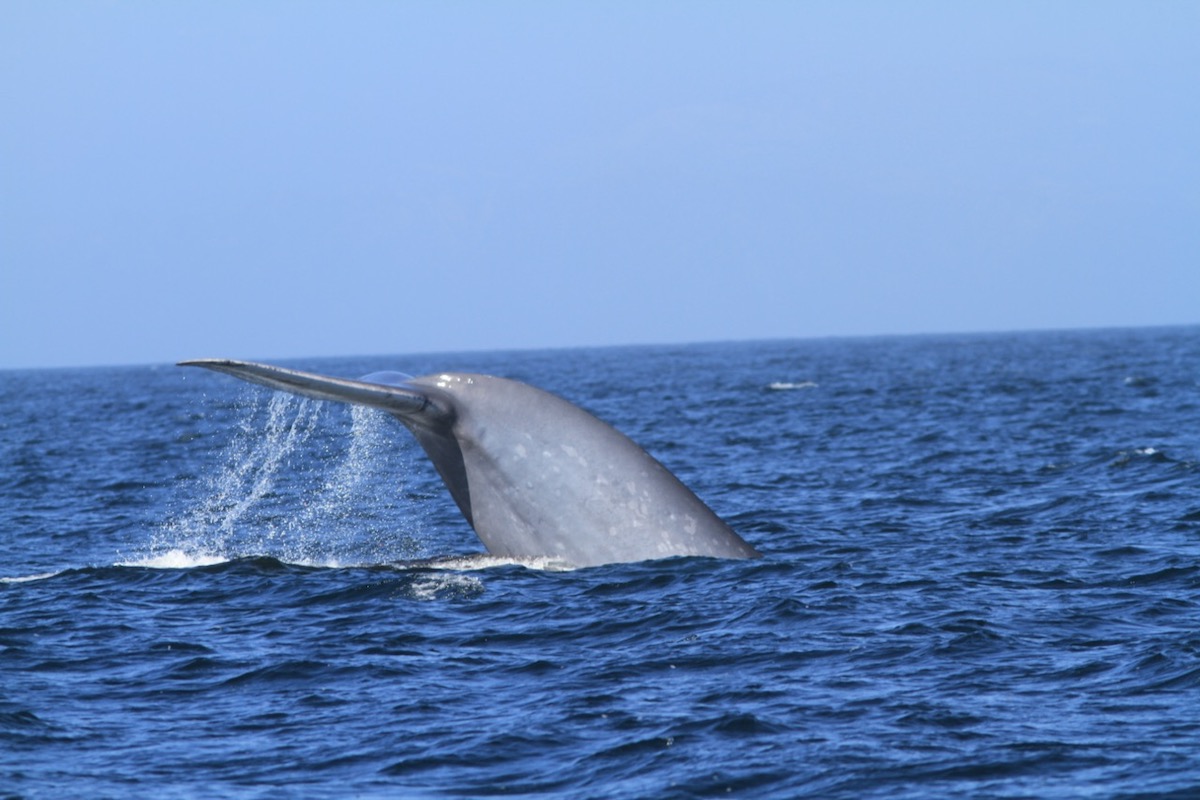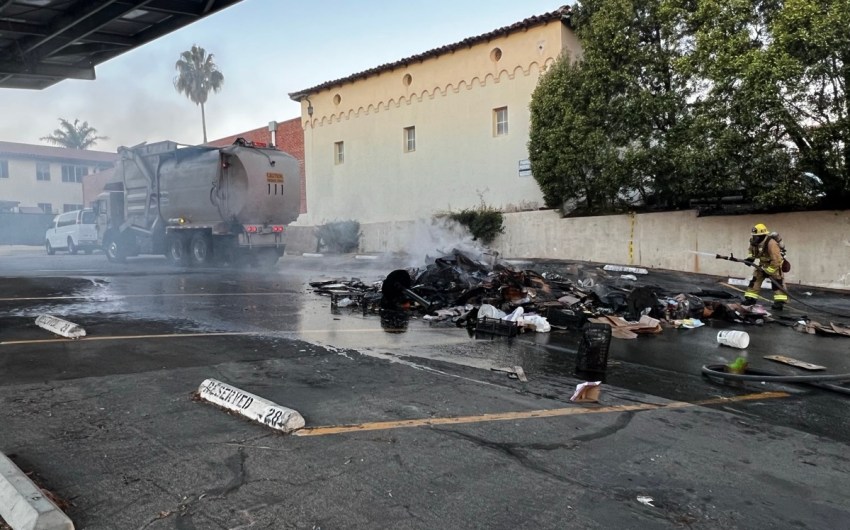Santa Barbara Channel Is Too Noisy for Whales to Hear
Santa Barbara Channel Is Too Noisy for Whales to Hear

Imagine two people trying to hold a conversation at the Santa Barbara Bowl. If the venue is empty, it would be easy, even from a distance.
Now imagine they are attending a sold-out rock ’n’ roll concert. Sound is resonating throughout the bowl-shaped amphitheater, drowning out the voices of people just a few seats away. Any attempts at conversation are difficult and muddled.
The Santa Barbara Channel, in a way, is like its own underwater amphitheater, full of whales and other creatures that rely on sound and echolocation to communicate and perceive the world around them. But, in terms of noise, these animals are in the middle of a perpetual rock concert.
For them, the once-quiet Channel can be noisier than a concert at the Bowl.
A recent study published in Marine Pollution Bulletin found that the Channel is about 30 times louder than it once was, pre–industrial revolution and before commercial shipping changed the soundscape.
The study compared noise levels from August 2017 to those of the same area before the introduction of cargo vessels in the 1950s. Back then, the channel’s baseline volume was around 60 to 80 decibels, which is a whisper compared to today’s levels. Now, the channel is up to 15 decibels louder.
“We’re increasingly concerned about how this affects marine life, and whales in particular, because their world is a world of sound,” explained Sean Hastings, a policy, information, and management officer with the Channel Islands National Marine Sanctuary.
“They use sound to communicate, to migrate, to find each other, to mate, to find food. And they certainly don’t depend on vision as much as humans, down in the deep, dark ocean. These animals have evolved a dependence on sound to survive.”
Not only is the Channel — a designated Whale Heritage Area — one of the most important whale migration routes in the United States, but it is also en route to the ports of Los Angeles and Long Beach, the two busiest ports in the Western Hemisphere.
Under the surface, it is where endangered humpbacks and Pacific blue whales forage, breed, and birth their calves. But above, it is a busy shipping lane where thousands of container ships transit cargo every year, creating a cacophony of noise in the process.
“It’s a really interesting human-wildlife interaction, where critical habitats are right up next to an industrialized ocean region,” said the study’s lead author, Vanessa ZoBell, a postdoctoral researcher at Scripps Institution of Oceanography.
Similar to the acoustics of the Bowl, sound in the channel gets trapped and resonates between the Channel Islands and the mainland. “In fact, it can be louder than the loudest concerts at Santa Barbara Bowl,” according to Hastings.

The frequency at which whales communicate is drowned out by the ships passing overhead. Container ships have tripled in number since the ’90s, the study says, and it’s only predicted to get worse.
“The noise masks the acoustics of whale calls,” Zobell explained. “So, they aren’t able to communicate as well with one another, which is extremely important for them because they undergo long migrations in an environment that’s 90 percent pitch-black,” she said.
In addition to overwhelming their senses, damaging their hearing structures, and interrupting their feeding patterns, noise pollution stresses whales out. Excessive noise causes their stress hormone levels to increase, which can also negatively impact a whale’s health (like all mammals). In some cases, such as with Navy sonar, noise pollution has even been linked to outright killing whales.
But it is not all “doom and gloom,” in the words of Hastings.
He pointed to Blue Whales and Blue Skies, a program that originated in the channel in 2014, aiming to reduce noise and greenhouse-gas emissions, as well as prevent fatal ship strikes on whales, by incentivizing shipping companies to reduce their speeds to 10 knots or less.
In 2023, 33 global shipping companies participated in the program, collectively traveling about 375,000 nautical miles at 10 knots or slower within the speed reduction zones along the Southern California coast and in areas of the San Francisco and Monterey Bay region.
Ships in the qualifying performance tiers had sound levels that were 5.4 decibels per transit lower when compared to 2016 baseline source levels, the organization reported, and “with a reduction in noise pollution, whales can likely communicate easier.”
The program is now looking to expand across the California coast via a bill authored by Santa Barbara Assemblymember Gregg Hart.
“We are working on ways to reduce ocean noise, while maintaining that vibrant maritime commerce that we all depend on,” Hastings said. “It’s certainly not as quiet as it used to be before big ships started sailing the world’s oceans. But it’s not as bad as it was when the ships were speeding through the channel…. And the industry is cooperating at higher and higher levels every year.”
ZoBell said that through her study, she wanted to see how wildlife were being negatively affected by noise pollution, “but I didn’t want to stop there,” she added.
“I wanted to take it a step further and try to find solutions for the modern ocean. So not only just say, ‘Hey, this is how the ocean is being degraded.’ But also, ‘Hey, this is what we were at historically; could we get back there someday?’”
Premier Events
Sat, Jun 15
11:00 AM
Santa Barbara
Mosaic Makers Market
Sat, Jun 15
5:00 AM
Santa Barbara
Grads & Dads at Finch & Fork
Sat, Jun 15
10:00 AM
Santa Barbara
APPLEBOX FREE Family Films at SBIFF’s Riviera Theatre
Sat, Jun 15
11:00 AM
Solvang
Amanda Darcy Book Signing
Sat, Jun 15
12:00 PM
Santa Barbara
Nic & Joe at La Cumbre Plaza
Sat, Jun 15
11:00 PM
Lompoc
JuneTeenth in Old Town Lompoc
Sun, Jun 16
11:00 AM
Santa Barbara
Juneteenth Celebration w/ Santa Barbara Ring Shout
Sun, Jun 16
5:00 PM
Santa Barbara
BLOOMSDAY! A Celebration of James Joyce’s Ulysses
Sun, Jun 16
6:00 PM
Santa Barbara
Contra Dance, Celtic folk band & Chris Page
Mon, Jun 17
8:00 PM
Solvang
PCPA Solvang Festival Theater Presents: “Little Shop of Horrors”
Fri, Jun 21
All day
Santa Barbara
Santa Barbara Summer Solstice Celebration 2024!
Sat, Jun 15 11:00 AM
Santa Barbara
Mosaic Makers Market
Sat, Jun 15 5:00 AM
Santa Barbara
Grads & Dads at Finch & Fork
Sat, Jun 15 10:00 AM
Santa Barbara
APPLEBOX FREE Family Films at SBIFF’s Riviera Theatre
Sat, Jun 15 11:00 AM
Solvang
Amanda Darcy Book Signing
Sat, Jun 15 12:00 PM
Santa Barbara
Nic & Joe at La Cumbre Plaza
Sat, Jun 15 11:00 PM
Lompoc
JuneTeenth in Old Town Lompoc
Sun, Jun 16 11:00 AM
Santa Barbara
Juneteenth Celebration w/ Santa Barbara Ring Shout
Sun, Jun 16 5:00 PM
Santa Barbara
BLOOMSDAY! A Celebration of James Joyce’s Ulysses
Sun, Jun 16 6:00 PM
Santa Barbara
Contra Dance, Celtic folk band & Chris Page
Mon, Jun 17 8:00 PM
Solvang
PCPA Solvang Festival Theater Presents: “Little Shop of Horrors”
Fri, Jun 21 All day
Santa Barbara

























You must be logged in to post a comment.